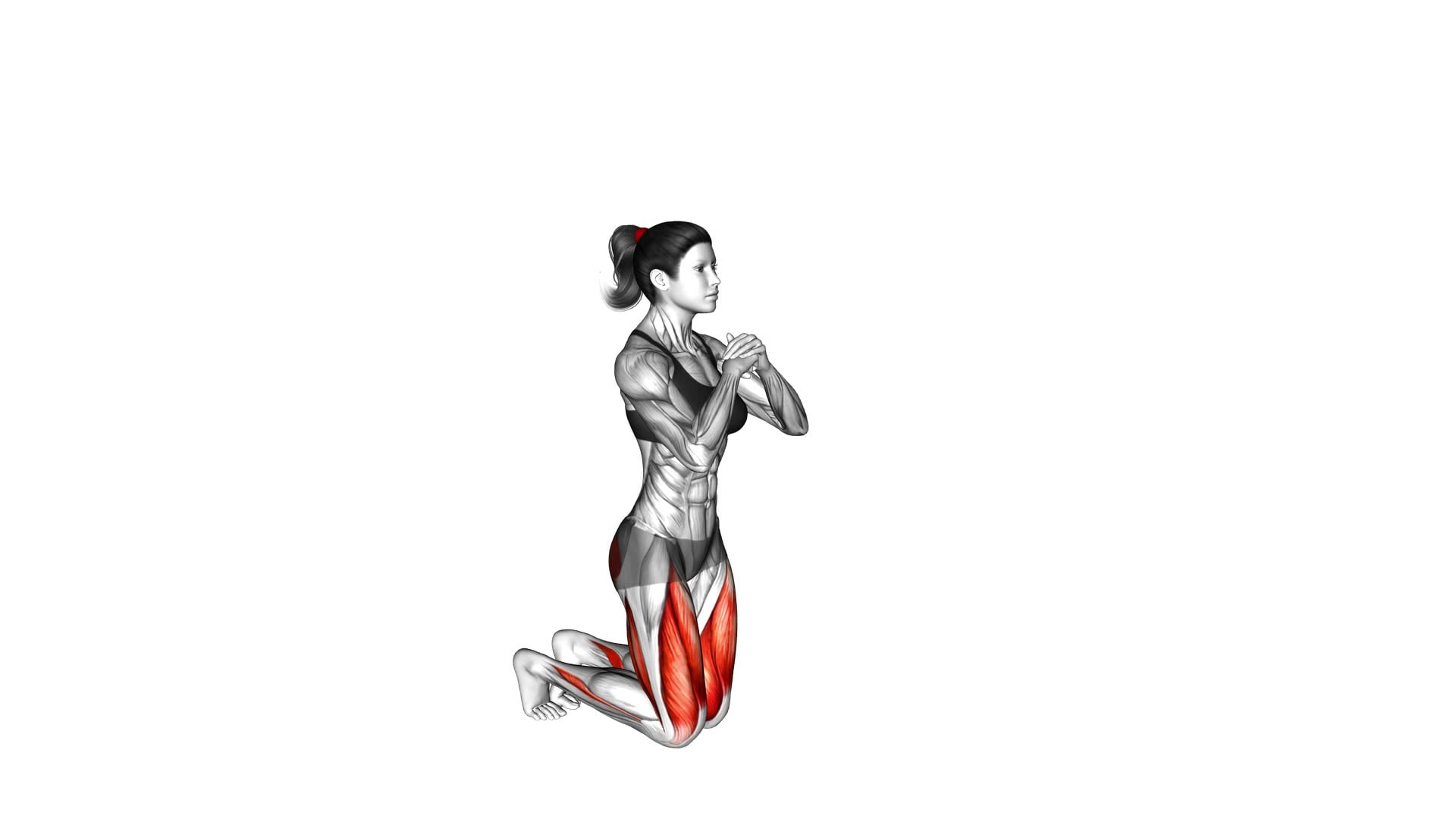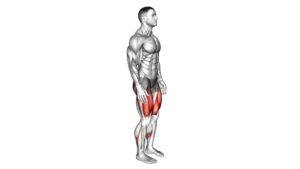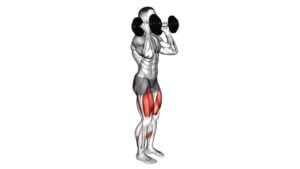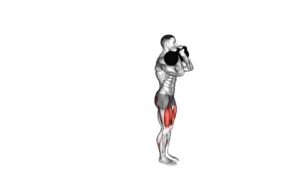Kneeling Hold to Stand (female) – Video Exercise Guide & Tips

Are you looking for a challenging exercise that targets your core and lower body? Look no further than the Kneeling Hold to Stand.
Watch This Exercise Video
This exercise requires you to transition from a kneeling position to standing, engaging your muscles and improving your balance.
In this video exercise guide, we will show you proper form and technique, modifications for beginners, advanced variations, and safety tips.
Get ready to strengthen and tone with this effective exercise. Let's get started!
Key Takeaways
- The Kneeling Hold to Stand exercise improves strength, mobility, balance, and overall physical performance.
- Proper form and technique include maintaining a straight back, engaging core muscles, and avoiding rounding the back or using momentum.
- Beginners can modify the exercise by using a stability ball or resistance band for support and gradually building strength in legs and core.
- Advanced variations and progressions include trying the single-leg Hold to Stand, adding weight, incorporating jumps, and engaging the inner thighs with a stability ball.
Benefits of the Kneeling Hold to Stand
Improve your strength and mobility by performing the Kneeling Hold to Stand exercise. This exercise has numerous benefits, including improving balance and increasing core strength. By incorporating the Kneeling Hold to Stand into your fitness routine, you can enhance your overall physical performance and improve your daily activities.
One of the key benefits of this exercise is its ability to improve balance. As you transition from a kneeling position to standing, you engage your core muscles, which help stabilize your body. This not only strengthens your core, but also enhances your body's ability to maintain balance in various activities, such as walking, running, or even performing more advanced exercises.
Additionally, the Kneeling Hold to Stand exercise targets and strengthens your core muscles. As you rise from the kneeling position, your abdominal muscles are activated, along with the muscles in your lower back and hips. This helps to increase core strength, which is essential for maintaining proper posture, preventing injuries, and improving overall stability.
Incorporating the Kneeling Hold to Stand exercise into your fitness routine can be a valuable addition, providing you with improved balance and increased core strength. Remember to perform this exercise with proper form and technique to maximize its benefits.
Proper Form and Technique
To perform the Kneeling Hold to Stand exercise correctly, follow these steps:
- Start by kneeling on the ground with your knees hip-width apart and your toes pointed behind you.
- Place your hands on your hips or cross them over your chest.
- Engage your core muscles and keep your back straight throughout the entire movement.
- Slowly lift your body up by pushing through your front foot and extending your hips and knees.
Common mistakes that people often make when performing the Kneeling Hold to Stand exercise include:
- Rounding the back: It's important to maintain a straight back throughout the movement to avoid straining the spine.
- Using momentum: Avoid using momentum to lift yourself up. Instead, focus on using your leg muscles to control the movement.
- Allowing the knees to cave in: Keep your knees in line with your toes to prevent unnecessary stress on the knees.
- Holding your breath: Remember to breathe continuously throughout the exercise to maintain proper oxygen flow.
Modifications for Beginners
If you're new to the Kneeling Hold to Stand exercise, there are modified versions available to help you build strength and improve your form. These beginner modifications are specifically designed for newbies who may not have the strength or flexibility to perform the full exercise yet.
One modification you can try is to use a stability ball. Start by kneeling in front of the stability ball with your hands resting on it for support. Slowly lean forward and bring your chest onto the ball, then push yourself back up to a kneeling position. This modification reduces the amount of weight placed on your arms and shoulders, making it easier for beginners to perform the movement.
Another modification is to use a resistance band. Begin by kneeling on the floor with the resistance band looped around your feet. Hold onto the band with your hands and slowly pull yourself up to a standing position, using the band for assistance. This modification helps to gradually build strength in your legs and core.
Advanced Variations and Progressions
Once you have mastered the beginner modifications, you can challenge yourself with advanced variations and progressions of the Kneeling Hold to Stand exercise.
These advanced modifications will help you to further strengthen your muscles and improve your overall fitness level. Here are four advanced variations and progressions to try:
- Single-leg Hold to Stand: Instead of using both legs to stand up, try doing the exercise with just one leg. This will require more stability and balance, as well as increased strength in the supporting leg.
- Weighted Hold to Stand: To add an extra challenge, hold a dumbbell or kettlebell in your hands while performing the exercise. This will increase the resistance and help to build more strength in your legs and core.
- Plyometric Hold to Stand: Incorporate explosive movements into the exercise by adding a jump at the end of the movement. This won't only target your leg muscles but also improve your power and agility.
- Stability Ball Hold to Stand: Place a stability ball between your legs and squeeze it as you stand up. This variation will engage your inner thigh muscles and improve your overall stability and control.
By incorporating these advanced modifications and muscle activation techniques, you can take the Kneeling Hold to Stand exercise to the next level and continue challenging your body.
Remember to always listen to your body and progress at a pace that's comfortable for you.
Safety Tips and Common Mistakes to Avoid
When performing the Kneeling Hold to Stand exercise, it's important to prioritize safety by following these tips and avoiding common mistakes.
To prevent injuries, it's crucial to warm up and prepare the body for kneeling exercises. Start by performing dynamic stretches for the lower body, such as leg swings or lunges, to increase blood flow and loosen up the muscles. This will help reduce the risk of strains or sprains during the exercise.
Another important injury prevention technique is to maintain proper form throughout the movement. Keep your core engaged and maintain a neutral spine alignment. Avoid excessive forward or backward leaning, as this can place unnecessary stress on the lower back. Additionally, make sure to keep your knees aligned with your toes and avoid any inward or outward collapsing of the knees.
Common mistakes to avoid include rushing through the exercise and using momentum to stand up. This not only reduces the effectiveness of the exercise but also increases the risk of injury. Instead, focus on controlled movements, using your muscles to lift yourself up.
Lastly, remember to breathe throughout the exercise and avoid holding your breath, as it can increase tension in the body.
Frequently Asked Questions
How Long Should I Hold the Kneeling Position Before Attempting to Stand Up?
Before attempting to stand up in the kneeling hold to stand exercise, it's important to hold the kneeling position for a sufficient amount of time. This allows you to build strength and stability in your muscles and joints.
Holding the position for around 10-15 seconds is a good starting point. By doing so, you can reap the benefits of proper form and avoid common mistakes like rushing the movement or losing balance.
Can the Kneeling Hold to Stand Exercise Help Improve Balance?
The kneeling hold to stand exercise can definitely help improve your balance. By challenging your stability and core strength, this exercise can enhance your overall balance and coordination.
There are also variations of the kneeling hold to stand that you can try to further challenge yourself and target different muscle groups.
Incorporating this exercise into your routine can be a great way to work on your balance and stability.
Is the Kneeling Hold to Stand Exercise Suitable for Individuals With Knee Injuries?
The kneeling hold to stand exercise can be beneficial for rehabilitation exercises, but it may not be suitable for individuals with knee injuries. If you have knee issues, it's essential to avoid exercises that exacerbate the problem.
Instead, focus on alternative exercises that are less strenuous on the knees, such as seated leg lifts or gentle squats.
Always prioritize your safety and consult with a healthcare professional for personalized advice.
Can This Exercise Be Performed Without the Use of Any Equipment?
Yes, you can perform the kneeling hold to stand exercise without any equipment. This exercise doesn't require any modifications or additional gear. It's a bodyweight exercise that focuses on improving your lower body strength and stability.
Beginners can start by using a chair or wall for support and gradually progress to performing the exercise without any assistance. The benefits of this exercise include strengthening your leg muscles, improving balance and coordination, and enhancing overall functional fitness.
How Often Should I Incorporate the Kneeling Hold to Stand Exercise Into My Workout Routine for Optimal Results?
To get optimal results, incorporate the kneeling hold to stand exercise into your workout routine regularly. The frequency of this exercise depends on your fitness level and goals. Doing it 2-3 times a week is a good starting point.
This exercise offers numerous benefits, such as improving core strength, stability, and mobility. It also targets your lower body muscles, including your glutes, quads, and hamstrings.
Consistency is key, so make sure to stay committed to your routine.
Conclusion
In conclusion, the kneeling hold to stand exercise is an effective way to improve strength and stability in the lower body. By practicing proper form and technique, you can maximize the benefits of this exercise.
Beginners can modify the exercise to suit their fitness level, while advanced individuals can challenge themselves with variations and progressions.
Remember to prioritize safety and avoid common mistakes to ensure a successful workout.
Incorporate the kneeling hold to stand into your fitness routine for stronger, more stable legs.

Author
Years ago, the spark of my life’s passion ignited in my mind the moment I stepped into the local gym for the first time. The inaugural bead of perspiration, the initial endeavor, the very first surge of endorphins, and a sense of pride that washed over me post-workout marked the beginning of my deep-seated interest in strength sports, fitness, and sports nutrition. This very curiosity blossomed rapidly into a profound fascination, propelling me to earn a Master’s degree in Physical Education from the Academy of Physical Education in Krakow, followed by a Sports Manager diploma from the Jagiellonian University. My journey of growth led me to gain more specialized qualifications, such as being a certified personal trainer with a focus on sports dietetics, a lifeguard, and an instructor for wellness and corrective gymnastics. Theoretical knowledge paired seamlessly with practical experience, reinforcing my belief that the transformation of individuals under my guidance was also a reflection of my personal growth. This belief holds true even today. Each day, I strive to push the boundaries and explore new realms. These realms gently elevate me to greater heights. The unique combination of passion for my field and the continuous quest for growth fuels my drive to break new ground.







